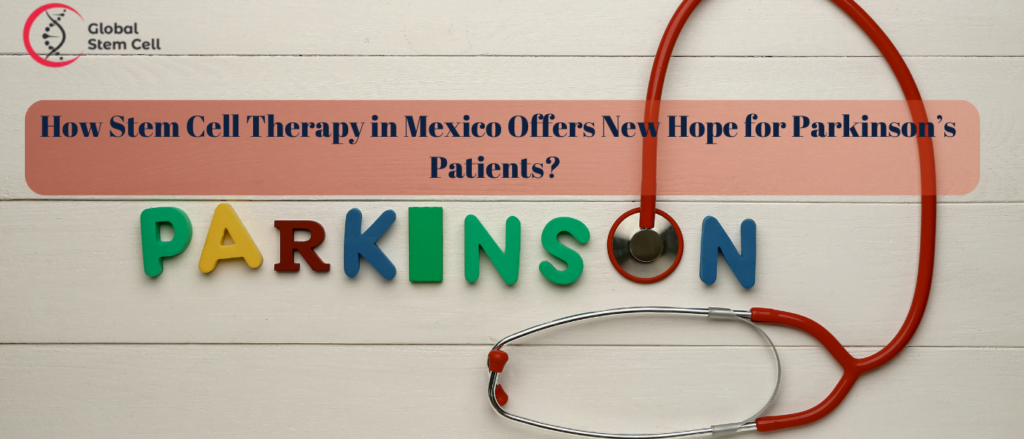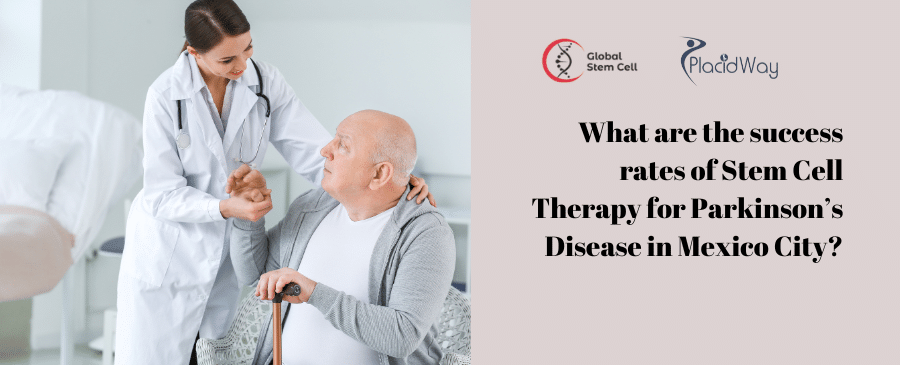
Parkinson’s Disease (PD) is a progressive neurological disorder that affects millions of people worldwide. Characterized by tremors, stiffness, and difficulty with movement and coordination, Parkinson’s can significantly impact the quality of life. Traditional treatments for Parkinson’s focus on managing symptoms, primarily through medication and physical therapy. However, these treatments often become less effective over time, leading patients to seek alternative options. Stem cell therapy has emerged as a promising treatment for Parkinson’s Disease, offering hope for slowing the progression of the disease and even reversing some of its effects. Mexico has become a leading destination for stem cell therapy, attracting patients from around the globe. In this blog post, we will explore how stem cell therapy is used to treat Parkinson’s Disease in Mexico, why Mexico is a preferred destination for this therapy, and what patients can expect from the treatment process.
Understanding Parkinson’s Disease
Parkinson’s Disease is a degenerative disorder of the central nervous system, primarily affecting the motor system. The disease is caused by the death of dopamine-producing neurons in a region of the brain known as the substantia nigra. Dopamine is a neurotransmitter that plays a critical role in regulating movement, and its deficiency leads to the hallmark symptoms of Parkinson’s, including tremors, bradykinesia (slowness of movement), muscle rigidity, and postural instability.
As Parkinson’s progresses, non-motor symptoms such as cognitive decline, mood disorders, and sleep disturbances may also develop. While there is no cure for Parkinson’s, treatments that address its symptoms can improve the quality of life for those living with the disease. However, the effectiveness of traditional treatments, such as levodopa and dopamine agonists, often diminishes over time, leading patients to seek alternative therapies.
How Stem Cell Therapy Works for Parkinson’s Disease
Stem cell therapy offers a novel approach to treating Parkinson’s Disease by focusing on regenerating the damaged neurons and restoring dopamine production in the brain. Stem cells have the unique ability to develop into different types of cells, including dopamine-producing neurons, making them an ideal candidate for treating neurodegenerative diseases like Parkinson’s.
There are several types of stem cells used in therapy for Parkinson’s Disease:
- Mesenchymal Stem Cells (MSCs): MSCs are derived from the patient’s own bone marrow or adipose (fat) tissue. These cells are known for their anti-inflammatory properties and their ability to differentiate into various cell types, including neurons. MSCs are commonly used in stem cell therapy for Parkinson’s to promote the regeneration of damaged neurons and reduce inflammation in the brain.
- Neural Stem Cells (NSCs): NSCs are specifically geared towards developing into neural cells, including neurons and glial cells. These stem cells can be introduced into the brain to replace the lost dopamine-producing neurons. Although less commonly used, NSCs are at the forefront of experimental treatments for Parkinson’s.
- Induced Pluripotent Stem Cells (iPSCs): iPSCs are created by reprogramming adult cells to an embryonic stem cell-like state. These cells can then be differentiated into dopamine-producing neurons. iPSC technology is still in the experimental stages, but it holds great promise for future Parkinson’s treatments.
Why Choose Mexico for Stem Cell Therapy for Parkinson’s Disease?
Mexico has rapidly become a top destination for stem cell therapy, including treatment for Parkinson’s Disease. Here are some reasons why patients choose Mexico for their stem cell therapy:
1. Advanced Medical Facilities
Mexico is home to several world-class medical facilities that specialize in stem cell therapy. These clinics are equipped with state-of-the-art technology and adhere to international standards of care, ensuring that patients receive high-quality treatment in a comfortable and professional environment.
2. Experienced Medical Teams
The medical teams in Mexico are often composed of doctors and researchers who are highly experienced in stem cell therapy. Many have received training in the United States or Europe and bring a wealth of knowledge and expertise to their practice. Their experience in treating Parkinson’s Disease with stem cells allows them to create personalized treatment plans tailored to each patient’s needs.
3. Affordability
One of the most significant advantages of seeking stem cell therapy in Mexico is the cost. Treatment in Mexico is often significantly more affordable than in the United States or Europe, with savings of up to 60-70% without compromising on the quality of care. This makes it an attractive option for patients who may not have access to such advanced therapies in their home countries due to high costs.
4. Accessibility and Convenience
Mexico’s proximity to the United States, combined with its well-developed tourism infrastructure, makes it an accessible and convenient destination for international patients. Many clinics offer assistance with travel arrangements, including transportation and accommodation, making the process as smooth as possible for patients and their families.

The Stem Cell Therapy Process for Parkinson’s Disease in Mexico
If you are considering stem cell therapy for Parkinson’s Disease in Mexico, here’s what you can expect from the treatment process:
1. Initial Consultation and Assessment
The process begins with an initial consultation and assessment, which can often be conducted remotely before you travel to Mexico. During this consultation, the medical team will review your medical history, conduct any necessary tests, and determine if you are a suitable candidate for stem cell therapy. This step is crucial to ensure that the treatment plan is tailored to your specific condition and needs.
2. Stem Cell Harvesting
If you are approved for treatment, the next step is the harvesting of stem cells. This is typically done using a minimally invasive procedure to collect stem cells from your bone marrow or adipose tissue. The procedure is performed under local anesthesia and is generally quick and painless. In some cases, stem cells from donors or pre-prepared iPSCs may be used, depending on the treatment protocol.
3. Stem Cell Processing
Once harvested, the stem cells are processed in a laboratory to isolate and concentrate them. This process enhances the potency and effectiveness of the cells when they are reintroduced into the patient’s body. In cases where neural stem cells or iPSCs are used, additional processing and differentiation steps may be involved.
4. Stem Cell Infusion or Injection
The processed stem cells are then infused or injected into the patient’s body. For Parkinson’s Disease, the delivery method may involve intravenous infusion or direct injection into the brain or cerebrospinal fluid, depending on the type of stem cells used and the treatment protocol. This procedure is typically performed on an outpatient basis, allowing patients to return to their accommodations the same day.
5. Post-Treatment Care and Monitoring
After the procedure, patients are advised to rest and avoid strenuous activities for a few days. The medical team will provide detailed post-treatment care instructions, including any medications, physical therapy, or lifestyle changes that may be necessary to support recovery. Follow-up appointments are essential to monitor the patient’s progress and make any necessary adjustments to the treatment plan.
Expected Outcomes and Success Rates
While stem cell therapy for Parkinson’s Disease is still considered experimental, many patients have reported positive outcomes following treatment. These outcomes can include:
- Improved Motor Function: Some patients experience improvements in tremors, muscle rigidity, and bradykinesia, leading to better mobility and coordination.
- Enhanced Quality of Life: Patients often report an overall improvement in their quality of life, including better sleep, mood, and the ability to perform daily activities.
- Slowed Disease Progression: Stem cell therapy may slow the progression of Parkinson’s by promoting the regeneration of dopamine-producing neurons and reducing neuroinflammation.
Choosing the Right Clinic in Mexico
Selecting the right clinic is a crucial step in the success of your stem cell therapy. Here are some tips to help you make an informed decision:
- Research Accreditation: Ensure that the clinic is accredited by international medical organizations and adheres to high standards of care.
- Evaluate the Medical Team: Look for clinics with experienced doctors and researchers who specialize in stem cell therapy for neurological conditions like Parkinson’s Disease.
- Read Patient Reviews: Patient testimonials can provide valuable insights into the clinic’s quality of care and the outcomes of previous treatments.
- Inquire About the Treatment Protocol: Ask about the specific types of stem cells used, the delivery method, and the expected outcomes. A reputable clinic should be transparent about its treatment process and success rates.
Cost of Stem Cell Therapy for Parkinson’s Disease in Mexico
Stem cell therapy for Parkinson’s Disease in Mexico offers a cost-effective alternative to treatments available in other countries, such as the United States and Europe. The cost of treatment can vary depending on several factors, including the type of stem cells used, the clinic’s reputation, and the specifics of the treatment plan. Below is an overview of the typical costs associated with different types of stem cell therapy for Parkinson’s Disease in Mexico:
| Type of Stem Cell Therapy | Cost in Mexico |
|---|---|
| Mesenchymal Stem Cell Therapy (MSC) | $10,000 – $20,000 |
| Neural Stem Cell Therapy (NSC) | $15,000 – $30,000 |
| Induced Pluripotent Stem Cell Therapy (iPSC) | $20,000 – $35,000 |
These costs are generally inclusive of initial consultation, stem cell harvesting and processing, the infusion or injection procedure, and post-treatment care. It’s important to discuss the exact pricing with your chosen clinic, as additional services or follow-up care may incur extra costs.
Top Clinics for Stem Cell Therapy for Parkinson’s Disease in Mexico
When considering stem cell therapy for Parkinson’s Disease in Mexico, selecting the right clinic is crucial. Below are some of the top clinics known for their expertise in treating neurological disorders with stem cell therapy:
1. Visani Stem Cells – Puebla, Mexico
Visani Stem Cells is a highly reputable clinic located in Puebla, Mexico. The clinic specializes in advanced stem cell therapies for neurological conditions, including Parkinson’s Disease. Visani is known for its cutting-edge technology, experienced medical team, and personalized treatment plans tailored to each patient’s unique needs.
2. Stem Health – Guadalajara, Mexico
Stem Health in Guadalajara is a leading clinic in regenerative medicine, offering comprehensive stem cell therapies for Parkinson’s Disease. The clinic’s approach combines the latest stem cell technologies with supportive therapies, aiming to enhance recovery and improve overall neurological function. Stem Health is recognized for its high standards of care and experienced practitioners.
3. Progencell – Tijuana, Mexico
Progencell is a well-established clinic in Tijuana, Mexico, known for its expertise in stem cell therapy for a wide range of conditions, including Parkinson’s Disease. The clinic offers a patient-centered approach, with a strong focus on achieving positive outcomes through personalized treatment plans. Progencell has received numerous positive reviews from patients who have undergone treatment there.
4. MexStemCells – Mexico City, Mexico
MexStemCells, located in Mexico City, is a premier clinic specializing in stem cell therapy and regenerative medicine. The clinic is particularly known for its work with neurodegenerative diseases like Parkinson’s. MexStemCells offers a comprehensive treatment program, utilizing the latest advances in stem cell technology to provide patients with the best possible care.
5. SPORTMED – Guadalajara, Mexico
SPORTMED is another top clinic in Guadalajara that focuses on regenerative medicine and neurological treatments. The clinic’s team of specialists is highly experienced in using stem cell therapy to treat Parkinson’s Disease, and they offer a range of options tailored to the specific needs of each patient. SPORTMED is known for its commitment to innovation and patient care.
Frequently Asked Questions
How does stem cell therapy work for Parkinson’s Disease?
Stem cells have the potential to develop into different types of cells, including neurons. In Parkinson’s, stem cell therapy works by introducing these cells into the brain, where they can differentiate into dopamine-producing neurons, helping to restore normal brain function and alleviate symptoms.
Who is a good candidate for stem cell therapy for Parkinson’s Disease?
Good candidates for stem cell therapy are typically individuals with early to mid-stage Parkinson’s Disease who have not responded well to traditional treatments. Candidates should be in overall good health, aside from their Parkinson’s symptoms, and should undergo a thorough evaluation by a specialist to determine eligibility.
What are the benefits of stem cell therapy for Parkinson’s Disease?
The benefits of stem cell therapy for Parkinson’s Disease may include improved motor function, reduced tremors and stiffness, enhanced quality of life, and potentially slowed disease progression. Some patients also report better cognitive function and mood following treatment.
How long does it take to see results from stem cell therapy for Parkinson’s Disease?
Results can vary among patients. Some may start to notice improvements within a few weeks to a few months after treatment, while others may take longer. The full benefits of stem cell therapy may continue to develop over several months as the cells work to repair and regenerate damaged tissues.
How do I choose the right clinic for stem cell therapy in Mexico?
When choosing a clinic, consider factors such as accreditation, the experience and expertise of the medical team, patient reviews, and the quality of facilities. It’s also important to ask about the specific types of stem cells used, the delivery method, and the expected outcomes.
Contact us today to learn more about stem cell therapy for Parkinson’s Disease in Mexico and schedule your consultation. Your journey to improved well-being starts here.









